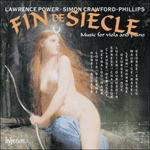
Welcome to Hyperion Records, an independent British classical label devoted to presenting high-quality recordings of music of all styles and from all periods from the twelfth century to the twenty-first.
Hyperion offers both CDs, and downloads in a number of formats. The site is also available in several languages.
Please use the dropdown buttons to set your preferred options, or use the checkbox to accept the defaults.

| Lawrence Power (viola), Simon Crawford-Phillips (piano)» More |
Pièce for cello or viola and piano was composed in 1897. Cast in a tranquil C major, the main theme is elaborated and developed throughout the work. Contrast is created through the inclusion of sections in varying pulses and keys. The piano and viola share melodic interest and also imitate each other’s lines. The opening theme returns in the coda.
from notes by Laura Hamer © 2016
La Pièce pour violoncelle ou alto et piano fut composée en 1897. Dans un ut majeur tranquille, le thème principal est élaboré et développé d’un bout à l’autre de l’œuvre. Le contraste est créé par l’inclusion de sections aux diverses pulsations et tonalités. Le piano et l’alto partagent l’intérêt mélodique et chacun imite en outre les lignes de l’autre. Le thème initial revient dans la coda.
extrait des notes rédigées par Laura Hamer © 2016
Français: Marie-Stella Pâris
Die Pièce für Cello oder Bratsche und Klavier wurde 1897 komponiert. Das Hauptthema, exponiert in ruhigem C-Dur, wird durchs gesamte Werk hindurch entwickelt und verarbeitet. Kontraste schaffen rhythmisch und tonartlich variierende Abschnitte. Das melodische Geschehen ist auf Klavier und Bratsche verteilt, beide ahmen ihre Melodien gegenseitig nach. In der Coda kehrt das Anfangsthema wieder.
aus dem Begleittext von Laura Hamer © 2016
Deutsch: Friedrich Sprondel
 Fin de siècle Fin de siècleAn irresistible programme of luscious French fare from one of the world’s foremost viola players.» More |

